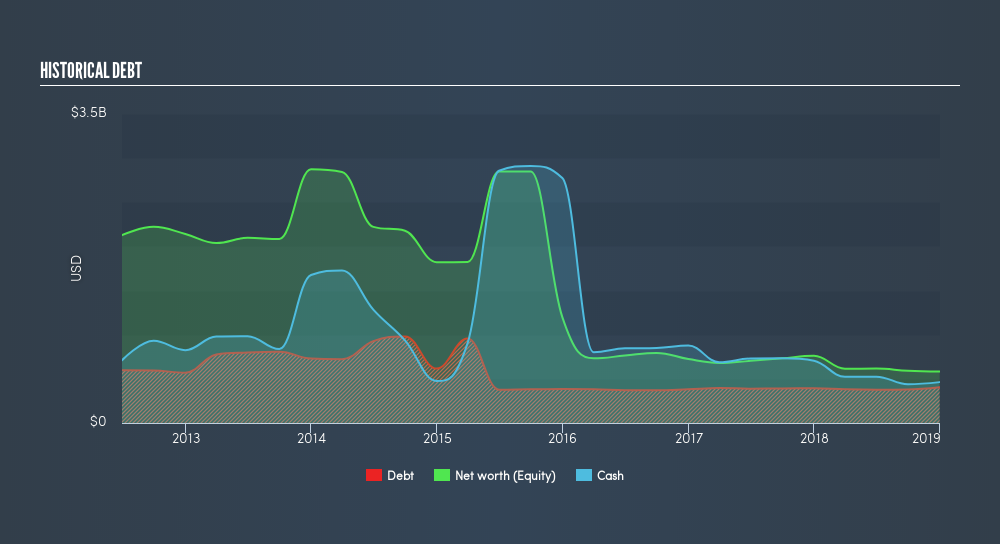- United States
- /
- Auto Components
- /
- NasdaqGS:VC
Is Visteon Corporation's (NASDAQ:VC) Balance Sheet Strong Enough To Weather A Storm?

Visteon Corporation (NASDAQ:VC) is a small-cap stock with a market capitalization of US$1.9b. While investors primarily focus on the growth potential and competitive landscape of the small-cap companies, they end up ignoring a key aspect, which could be the biggest threat to its existence: its financial health. Why is it important? Understanding the company's financial health becomes essential, as mismanagement of capital can lead to bankruptcies, which occur at a higher rate for small-caps. The following basic checks can help you get a picture of the company's balance sheet strength. However, these checks don't give you a full picture, so I suggest you dig deeper yourself into VC here.
Does VC Produce Much Cash Relative To Its Debt?
Over the past year, VC has maintained its debt levels at around US$405m – this includes long-term debt. At this current level of debt, VC's cash and short-term investments stands at US$463m to keep the business going. Additionally, VC has produced US$204m in operating cash flow during the same period of time, leading to an operating cash to total debt ratio of 50%, indicating that VC’s current level of operating cash is high enough to cover debt.
Can VC pay its short-term liabilities?
Looking at VC’s US$721m in current liabilities, it seems that the business has maintained a safe level of current assets to meet its obligations, with the current ratio last standing at 1.8x. The current ratio is the number you get when you divide current assets by current liabilities. Usually, for Auto Components companies, this is a suitable ratio as there's enough of a cash buffer without holding too much capital in low return investments.

Does VC face the risk of succumbing to its debt-load?
VC is a relatively highly levered company with a debt-to-equity of 70%. This is a bit unusual for a small-cap stock, since they generally have a harder time borrowing than large more established companies. We can check to see whether VC is able to meet its debt obligations by looking at the net interest coverage ratio. A company generating earnings before interest and tax (EBIT) at least three times its net interest payments is considered financially sound. In VC's, case, the ratio of 31.57x suggests that interest is comfortably covered, which means that lenders may be willing to lend out more funding as VC’s high interest coverage is seen as responsible and safe practice.
Next Steps:
Although VC’s debt level is towards the higher end of the spectrum, its cash flow coverage seems adequate to meet obligations which means its debt is being efficiently utilised. This may mean this is an optimal capital structure for the business, given that it is also meeting its short-term commitment. I admit this is a fairly basic analysis for VC's financial health. Other important fundamentals need to be considered alongside. I suggest you continue to research Visteon to get a more holistic view of the small-cap by looking at:
- Future Outlook: What are well-informed industry analysts predicting for VC’s future growth? Take a look at our free research report of analyst consensus for VC’s outlook.
- Valuation: What is VC worth today? Is the stock undervalued, even when its growth outlook is factored into its intrinsic value? The intrinsic value infographic in our free research report helps visualize whether VC is currently mispriced by the market.
- Other High-Performing Stocks: Are there other stocks that provide better prospects with proven track records? Explore our free list of these great stocks here.
We aim to bring you long-term focused research analysis driven by fundamental data. Note that our analysis may not factor in the latest price-sensitive company announcements or qualitative material.
If you spot an error that warrants correction, please contact the editor at editorial-team@simplywallst.com. This article by Simply Wall St is general in nature. It does not constitute a recommendation to buy or sell any stock, and does not take account of your objectives, or your financial situation. Simply Wall St has no position in the stocks mentioned. Thank you for reading.
About NasdaqGS:VC
Visteon
An automotive technology company, designs, manufactures, and sells automotive electronics and connected car solutions for vehicle manufacturers.
Flawless balance sheet and good value.
Similar Companies
Market Insights
Community Narratives





